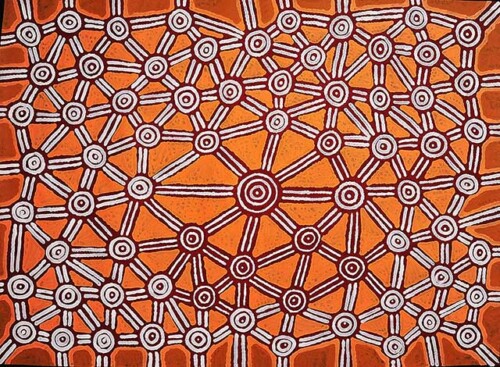Major Prize Winner, Makinti Napanangka from Kintore in the Northern Territory has been awarded Australia’s premier Indigenous art prize at the 25th Telstra National Aboriginal & Torres Strait Islander Art Award.
The winning painting depicts designs associated with the site of Lupulnga, a rockhole situated south of the Kintore Community. The Peewee (small bird) Dreaming is associated with this site, as well as the Kungka Kutjarra or Two Travelling Women Dreaming.
The $4,000 Telstra General Painting Award was awarded to Doreen Reid Nakamarra, originally from the Warburton Ranges, Western Australia for her untitled work. Doreen’s painting depicts designs associated with the rockhole site of Marrapinti, west of the Pollock Hills in Western Australia.
The $4,000 Telstra Bark Painting Award was awarded to Terry Ngamandara Wilson from Gochan Jiny-jirra in the Northern Territory, for his work Gulach “ Spike Rush. A senior custodian of the Gun-gulol Gu-rrenyinga group of clans Terry’s work depicts a key emblem of the clans. It is a design for gulach, the spike rush that dominates the Barlparnarra swamp country.
The $4,000 Telstra Works on Paper, was awarded to Dennis Nona from Badu Island, Torres Strait, Queensland, for his etching on paper, Dugam. Winner of last year’s $40,000 Telstra Award for his 3.5m bronze crocodile Ubirikubiri, Dennis is widely acknowledged as an important Torres Strait Islander artist. His entry in this year’s award is named after the star that is visible in the early morning sky for about two weeks during August and September. Its presence tells the Torres Strait Islanders that it is the time to harvest the wild yams, kutai, gabau and saurr.
The $4,000 Wandjuk Marika Three-Dimensional Memorial Award, sponsored by Telstra, was awarded to Yolgnu artist Nyapanyapa Yunupingu from Yirrkala in the Northern Territory, for her work Incident at Mutpi (1975). This installation consists of a bark painting and the artist’s narrative of the event Gatapangawuy Dhawu “ Buffalo Story filmed by The Mulka Project. The bark painting and accompanying film are based on an incident from the 1970’s when Nyapanyapa was badly gored by a buffalo.

